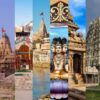Top 20 Spiritual Places in India.
India, a land of diverse cultures, traditions, and beliefs, is also home to many sacred places that have been revered by Hindus for centuries. These spiritual destinations not only hold immense religious significance but also offer an opportunity for deep introspection, peace, and spiritual growth. Below is a list of the top 20 spiritual places in India every Hindu should visit, complete with details on what to do and the best time to visit each location.
Varanasi (Kashi) – Uttar Pradesh
Significance: One of the oldest living cities in the world and the holiest city for Hindus. It is the birthplace of Lord Shiva and an important pilgrimage spot for those seeking moksha (liberation from the cycle of rebirth).
What to Do: Take a holy dip in the Ganges River at Dashashwamedh Ghat, visit Kashi Vishwanath Temple, and attend the Ganga Aarti in the evening.
Best Time to Visit: October to March (for pleasant weather). Avoid summer months as the heat can be intense.
Tirupati – Andhra Pradesh
Significance: Home to the famous Tirumala Venkateswara Temple, dedicated to Lord Venkateswara (an incarnation of Vishnu), this is one of the richest and most visited temples in the world.
What to Do: Visit the Tirumala Temple, take part in the seva (voluntary services), and experience the Laddu prasad (sacred offering).
Best Time to Visit: September to March, as the weather is relatively cooler.
Rishikesh – Uttarakhand
Significance: Known as the ‘Yoga Capital of the World,’ Rishikesh is a revered place for meditation, spiritual awakening, and learning yoga.
What to Do: Attend the Ganga Aarti at Triveni Ghat, practice yoga and meditation, and visit the Beatles Ashram.
Best Time to Visit: March to May and September to November.
Haridwar – Uttarakhand
Significance: A holy city where the River Ganges enters the plains. Haridwar is a key pilgrimage destination for Hindus and is known for its temples and ghats
What to Do: Attend the evening Ganga Aarti at Har Ki Pauri, take a dip in the Ganges, and visit the Mansa Devi Temple.
Best Time to Visit: September to April.
Amritsar – Punjab
Significance: Though primarily a Sikh pilgrimage site, the Golden Temple (Harmandir Sahib) has immense spiritual significance for all. It is a symbol of selfless service, humility, and devotion.
What to Do: Visit the Golden Temple, take part in the Langar (community kitchen), and explore the Jallianwala Bagh.
Best Time to Visit: November to March.
Vaishno Devi – Jammu & Kashmir
Significance: Located in the Trikuta Mountains, Vaishno Devi is one of the holiest Hindu shrines dedicated to Goddess Vaishno, an incarnation of Durga.
What to Do: Hike up to the temple, seek blessings of the Goddess, and explore the nearby Bhairav Temple.
Best Time to Visit: April to October, avoid winters due to heavy snowfall.
Badrinath – Uttarakhand
Significance: Badrinath Temple, dedicated to Lord Vishnu, is one of the Char Dham pilgrimage sites, attracting millions of devotees.
What to Do: Visit the Badrinath Temple, bathe in the Tapt Kund hot spring, and explore nearby attractions like Mana Village and Vasudhara Falls.
Best Time to Visit: May to October.
Somnath – Gujarat
Significance: The Somnath Temple is one of the 12 Jyotirlingas, revered shrines dedicated to Lord Shiva. It is a historical site that has been rebuilt after multiple destructions.
What to Do: Visit the Somnath Temple, enjoy the Aarti and the evening sound and light show.
Best Time to Visit: October to March.
Kedarnath – Uttarakhand
Significance: A part of the Char Dham, Kedarnath Temple is dedicated to Lord Shiva and is one of the holiest sites in the Himalayan range.
What to Do: Trek up to the Kedarnath Temple, seek Lord Shiva’s blessings, and enjoy the pristine surroundings.
Best Time to Visit: May to October (before the onset of winter).
Dwarka – Gujarat
Significance: Dwarka is one of the four Char Dham pilgrimage sites and is dedicated to Lord Krishna. The city is believed to have been the kingdom of Lord Krishna.
What to Do: Visit the Dwarkadhish Temple, explore the Dwarka Beach, and take a boat ride to the Bet Dwarka Island.
Best Time to Visit: October to March.
Pushkar – Rajasthan
Significance: Pushkar is famous for its temple dedicated to Lord Brahma, the only one in India. It is also known for the annual Pushkar Camel Fair.
What to Do: Visit the Brahma Temple, take a holy dip in the Pushkar Lake, and experience the vibrant Pushkar Fair (held in November).
Best Time to Visit: October to March.
Mahabalipuram – Tamil Nadu
Significance: Known for its UNESCO-listed temples and rock-cut sculptures, Mahabalipuram is an important spiritual destination with a mix of Hindu history and architecture.
What to Do: Visit the Shore Temple, Arjuna’s Penance, and the Five Rathas.
Best Time to Visit: November to February.
Kanchipuram – Tamil Nadu
Significance: Kanchipuram is known as the “City of a Thousand Temples,” with major temples dedicated to Shiva, Vishnu, and Devi.
What to Do: Visit the Ekambareswarar Temple, Kailasanathar Temple, and shop for traditional Kanchipuram silk sarees.
Best Time to Visit: October to March.
Nashik – Maharashtra
Significance: Nashik is a part of the famous Panchavati and is known for its association with Lord Rama. It is also an important site for the Kumbh Mela.
What to Do: Visit the Trimbakeshwar Temple (one of the 12 Jyotirlingas), take a holy dip in the Godavari River, and explore the Pandav Leni caves.
Best Time to Visit: October to March.
Kanchipuram – Tamil Nadu
Significance: Known as the City of Thousand Temples, Kanchipuram is one of India’s most important pilgrimage sites.
What to Do: Visit the famous Kailasanathar Temple, Ekambareswarar Temple, and Varadaraja Perumal Temple.
Best Time to Visit: October to March.
Shirdi – Maharashtra
Significance: The home of the revered saint Sai Baba, Shirdi is a significant pilgrimage site for millions of devotees.
What to Do: Visit the Sai Baba Temple, attend the Aarti ceremony, and explore the Samadhi Mandir.
Best Time to Visit: September to March.
Sabarimala – Kerala
Significance: Sabarimala is dedicated to Lord Ayyappa and is one of the largest pilgrimage sites in the world.
What to Do: Visit the Sabarimala Temple, take part in the pilgrimage (which involves fasting and wearing traditional attire).
Best Time to Visit: November to January.
Ramanagaram – Karnataka
Significance: Known for the Sri Ramadevara Betta (hill of Lord Rama), Ramanagaram is a revered site for pilgrims and trekkers.
What to Do: Visit the temple on the hill, trek to the top, and enjoy panoramic views.
Best Time to Visit: October to March.
Tiruchendur – Tamil Nadu
Significance: Tiruchendur is home to the Murugan Temple, one of the six abodes of Lord Murugan.
What to Do: Visit the Tiruchendur Murugan Temple and take a dip in the temple’s sacred waters.
Best Time to Visit: October to March.
Mount Abu – Rajasthan
Significance: The only hill station in Rajasthan, Mount Abu is home to the famous Dilwara Temples dedicated to Jain Tirthankaras, though it also attracts Hindu pilgrims.
What to Do: Visit the Dilwara Temples, take a boat ride in Nakki Lake, and enjoy the cool climate.
Best Time to Visit: October to March.
Mahakaleshwar – Ujjain, Madhya Pradesh
Significance: The Mahakaleshwar Temple in Ujjain is one of the most sacred and revered temples in India. It is dedicated to Lord Shiva and is one of the twelve Jyotirlingas, which are considered the holiest of Shiva shrines in Hinduism. The temple is located on the banks of the Shipra River in the ancient city of Ujjain, which has a rich historical and spiritual significance.
What to Do: Visit the Mahakaleshwar Temple:
The primary activity at the temple is offering prayers to Lord Mahakal. The temple is known for its stunning architecture and serene ambiance. Devotees visit to seek blessings for health, wealth, and spiritual progress. The Shivalinga at Mahakaleshwar is believed to be Swayambhu (self-manifested), which adds to the sanctity of the temple.
Best Time to Visit: The best time to visit Mahakaleshwar is between October to March.
Kainchi Dham – Uttarakhand
Significance:The temple and ashram are nestled in the foothills of the Himalayas and are considered a sacred spot for meditation and seeking blessings from Neem Karoli Baba, who is believed to have performed numerous miracles during his lifetime.
What to Do: Visit the Temple:
The main temple at Kainchi Dham is dedicated to Lord Hanuman, but it also has other deities like Lord Ram and Lakshman. Pilgrims visit the temple to offer their prayers, seek divine blessings, and meditate in the peaceful surroundings. The atmosphere at the temple is calm and devotional, making it an ideal place for reflection.
Best Time to Visit: The best time to visit Kainchi Dham is between April and October.
Each of these 20 spiritual places offers a unique experience for spiritual seekers, providing a sense of peace, purpose, and divine connection. Whether you’re seeking moksha, wish to experience the beauty of ancient architecture, or just wish to immerse yourself in the deep spiritual energy of India, these destinations are a must-visit. Time your visits based on the weather to ensure a pleasant and enriching experience!





